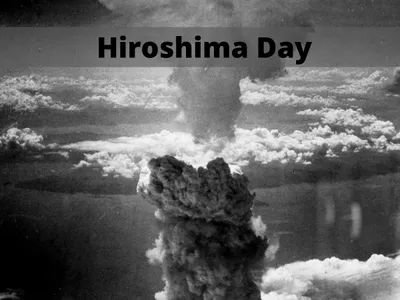Blog
Hiroshima Day 2024

Every August 6, Hiroshima Day is observed as a solemn occasion to advocate for peace politics and raise awareness of the catastrophic consequences of the atomic bomb attack on Hiroshima.
This date, back in 1945, marked the tragic loss of thousands of lives in an instant due to the detonation of an atomic weapon, making Hiroshima the first city to suffer such a devastating nuclear attack.
History of Hiroshima Day
The historical context reveals that in 1945, the United States deployed two atomic bombs, named ‘The Little Boy’ and ‘The Fat Man,’ on Hiroshima and Nagasaki on August 6 and 9, respectively.
The bombing of Hiroshima resulted in the loss of 39 per cent of the city’s civilian population.
Significance of Hiroshima Day
The significance of Hiroshima Day lies in its role as a platform for anti-war and anti-nuclear demonstrations across many countries.
People often visit the Hiroshima Peace Memorial Museum on this day, where the archives document the devastating impact of the atomic bombing during World War II.
Facts about Hiroshima Day
- It was a Monday, and at about 8:15 a.m. on August 6, 1945, the atomic bomb was dropped on Hiroshima.
- The bomb was named Little Boy.
- The bomb was dropped by American Boeing B-29 Superfortress, named Enola Gay. It was flown by Paul Tibbets (23 February 1915 – 1 November 2007).
- The blast immediately killed around 80,000 and injured over 35,000.
- Before the blast, Hiroshima had around 90,000 buildings out of which only 28,000 remained after the explosion.
- The United States used to warn the Japanese civilians about potential air raids for months and it reportedly dropped over 63 million leaflets across Japan. However, the US did not give any warning about the much more destructive atomic bombing before dropping the bomb on Hiroshima.
- The bomb was to be dropped on Aioi Bridge but it missed the target due to crosswind and instead detonated directly over Shima Surgical Clinic.
- The Little Boy released the equivalent energy of 16 ± 2 kilotons of TNT but was in fact considered very inefficient as it released only 1.7 per cent of its material fissioning, according to Wikipedia.
- The bomb’s radius of total destruction was about 1.6 kilometres while fires engulfed about 11 square km.
- The bomber, Enola Gay, stayed over the target area for two minutes and was 16 kilometres away when the bomb detonated.
The impact of the bombing on Hiroshima
Hiroshima stands on a flat river delta, with few hills or natural features to limit the blast. The bomb was dropped in the city centre, an area crowded with wooden residential structures and places of business. These factors meant that the death toll and destruction in Hiroshima was particularly high.
The firestorm in Hiroshima destroyed 13 square kilometres (five square miles) of the city. Almost 63% of the buildings in Hiroshima were completely destroyed and many more were damaged. In total, 92% of the structures in the city were either destroyed or damaged by blast and fire.
Estimates of total deaths in Hiroshima have generally ranged between 100,000 and 180,000, out of a population of 350,000. Tens of thousands died immediately and many more in the days and months that followed.
The impact of the bombing on Nagasaki
Due to the hilly geography of Nagasaki and the bombing focus being away from the city centre, the excessive damage from the bombing was limited to the Urakami Valley and part of downtown Nagasaki. The centre of Nagasaki, the harbour, and the historic district were shielded from the blast by the hills around the Urakami River.
The nuclear bombing did nevertheless prove devastating, with approximately 22.7% of Nagasaki’s buildings being consumed by flames, but the death toll and destruction were less than in Hiroshima. Estimates of casualties from Nagasaki have generally ranged between 50,000 and 100,000, with many dying instantaneously and others dying slowly and agonisingly as a result of burns and radiation.
Effect of a nuclear weapon
These two events still resonate to this day and serve as the greatest warning of the devastating effects of nuclear weapons.
As well as the high death toll, those that survived the initial detonation and firestorms quickly became ill with radiation poisoning with symptoms ranging from severe burns, hair loss, nausea and bleeding. This was compounded by the fact that 90% of medical staff in both cities were either killed or disabled and what medical supplies existed quickly ran out. Long after the bombings, survivors were still suffering from increased susceptibility to leukaemia, cataracts and malignant tumours with many also being diagnosed with post-traumatic stress disorder later in life.
This suffering goes beyond the survivors. Future generations either born to survivors or born to those living in Hiroshima for years to come had increased chances of small brain sizes, delayed development, blindness and increased susceptibility to leukaemia and other cancers. The bombings of both Hiroshima and Nagasaki represent a human tragedy which should never be repeated.
The Hibakusha (survivors of the bomb) have campaigned for many years to have the impact of nuclear weapons acknowledged. They have educated generations on the subject, a contributing factor in the growing international momentum focused on the humanitarian impact of these weapons.
International momentum
In 2010 the Nuclear Non-Proliferation Treaty (NPT) Review Conference’s final document officially expressed ‘deep concern at the catastrophic humanitarian consequences of any use of nuclear weapons’ for the first time. Following this, a group of countries began delivering joint statements on the humanitarian impact of nuclear weapons. This movement was the precursor to demands at the United Nations for a global nuclear weapons ban.
The historical experience of the use and testing of nuclear weapons, including at Hiroshima and Nagasaki, has demonstrated their devastating immediate and long-term effects. No political circumstances can justify their use. And of course, today’s nuclear bombs are many times more powerful than the ones used on Japan in 1945.
The International Red Cross has identified further humanitarian consequences of a nuclear explosion, including widespread famine and the destruction of medical facilities and personnel. The organisation has stated that the global humanitarian community would never be able to effectively respond to the aftermath of a nuclear conflict. An International Red Cross report recently stated, ‘We are not talking about the possibility of another Hiroshima and Nagasaki, horrendous as they were. We are facing the prospect of something much, much worse.’
Increasing awareness of the impact of a nuclear bomb, building on what we know from the attacks in 1945, contributes to a growing sense of urgency in the international community about securing an end to nuclear weapons.















